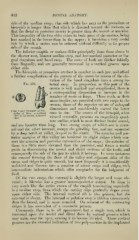Page 432 - My FlipBook
P. 432
442 DENTAL ANATOMY.
side of the median cusp ; that side which lies next to the premolars or
bicuspids is longer than that which is directed toward the incisors, so
that the distal or posterior moiety is greater than the mesial or anterior.
This inequality of the two sides exists in both pairs of the canines, being
it furnishes a very useful
less marked in the lower than in the upper ;
rule by which a canine can be referred without difficulty to its proper
side of the mouth.
The inferior cuspids or canines differ principally from those above in
the shorter root, blunter median cusp, and less-marked posterior or lin-
gual cingulum and basal cusp. The roots of both are thicker labially
than lingually, and are generally traversed by a vertical groove upon
either side.
The bicuspids or premolars are four in number in each jaw, and afford
a further complication of the pattern of the crown by reason of the ele-
vation of the basal cingulum into a strong in-
FiG. 220. ternal cusp. In proportion as this part of the
crown is well marked and complicated, there is
a corresponding disposition to increase in the
number of roots or fangs. These teeth, as their
name implies, are provided with two cusps to the
crown ; those of the superior set are of subequal
dimensions and considerablv exceed the lower
First Upper Bicuspid or Pre- . . ^tm <• ji i • • i i
molar of Wan: o, vertical OUCS lU SlZC. illC CrOWU ot tllC blCUSpid, whCU
view of the crown; 6, lateral
^,-^^^,^^1 vertically, prescuts au imperfectly quad-
rate outline, which is most distinct in the second,
and are broader than long. Two strong cusps, of which one is exter-
nal and the other internal, occupy the grinding face, and are separated
by a deep notch or valley, deepest in the centre. The anterior and pos-
terior margins of this valley are bordered by slight ridges which con-
nect the anterior and posterior extremities of the cusps ; the anterior of
these is a little more elevated than the posterior, and forms a useful
guide in determining the mesial and distal surfaces of the tooth, and
consequently the side of the jaw to which it belongs. In some instances
the enamel forming the floor of the valley and adjacent sides of the
cusps and ridges is quite smooth, but most frequently it is considerably
wrinkled and thrown into a number of minor cusps and ridges, -with
intermediate indentations which offer receptacles for the lodgment of
food.
Of the two cusps, the external is slightly the larger and more ele-
vated ; it likewise has a greater 'antero-posterior extent. Its form is
very much like the entire crown of the cuspid, terminating superiorly
in a median cusp, from which the cutting edge gradually slopes away
upon either side. The internal vertical rib is also present, but the
external is absent. The internal or palatine cusp is thicker transversely
than the buccal, and is more rounded. On account of the connecting
ridges it has somewhat of a crescentic pattern.
Commonly, there is, to all a])])earance, but a single root, which is
traversed upon the mesial and distal faces by vertical grooves which
may unite near the apex, causing it to become divided. These vertical
grooves are the external indication of two pulp-cavities in the implanted


